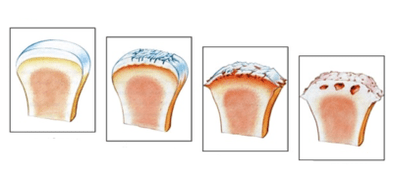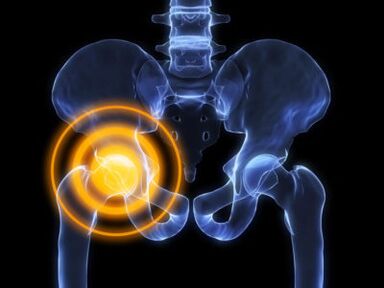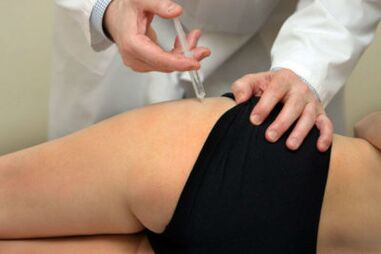Hip joint osteoarthritis is a complex disease with specific symptoms and complex treatment.The disease occurs in the context of metabolic disorders in the cartilaginous tissue of the joint cavity and the head of the femur.
Osteoarthritis of hip or coksartrose joint is more common in the elderly.It is generally accepted that an inflammatory reaction plays the main role in the pathogenesis of the disease.After a large number of studies, osteoarthritis has been proven to occur with atherosclerosis and diseases with metabolic disorders.
The essence of the disease
Coksartrose is a disease based on metabolic disorders with atrophic and degenerative changes in the tissue of the hip joint.
You cannot confuse osteoarthritis with arthritis.Unlike osteoarthritis arthritis, non -infectious (aseptic) inflammation occurs, which develops and progresses for many years.
Development pathogenesis:
- Violation of metabolic processes in cartilage.The cartilage fabric receives nutrients using diffusion.The slightest inflammation or edema leads to a lack of traces of elements and minerals.
- In the context of the nutritional altered processes, atrophic changes begin, the cartilage fabric is refined, the amount of joint fluid and chondroblasts decreases.
- Due to the madness and destruction of cartilage, intense pain begins, there is a decrease in the amplitude of movements in the joints.
- The cartilage fabric is very sophisticated, the fabulous slit narrows, joint dystrophy occurs.
Until the start of dystrophy, for more than a year, takes place.The disease can only be stopped at the first stages, with the development of the third stage of osteoarthrosis, the treatment aims to reduce symptoms and allege the life of the patient, an alternative to drugs - endoprothetics.
Reasons

The disease is polyetiological, there are many conditions and factors that can cause osteoarthritis or cause its progression.If the causes of osteoarthritis of the hip joint are not detected, such a disease is called idiopathic osteoarthritis.
The disease is not hereditary, but genetic pathologies in which cartilage dysplasia occurs can cause osteoarthritis of the hip joint.
In addition, the cause of coksartrosis can be such diseases:
- Loss syndrome - A characteristic sign of the disease is a violation of the delivery of nutrients to the cartilage tissue of the joint and the femoral head.This happens in childhood, mainly boys are sick.
- Congenital dislocations and subluxation of the femur.In the injury process, an inflammatory reaction and an aseptic fusion of the cartilage tissue and the femoral head can occur.
- Necrosis of the femoral head.It occurs due to damage to the upper artery, which is attached to the upper head.
- Rheumatoid and juvenile arthritis.In the context of the action of toxins or clean antibodies, exudative inflammation develops in the joint.
Since the disease progresses slowly, the disease can be on one side and two.
There are many factors contributing to the occurrence of osteoarthritis, they include:
- Vertebral column diseases (cyphosis, lordosis, scoliosis);
- Metabolic diseases of connective tissue;
- Blood supply violation at the joint;
- atherosclerosis of large vessels;
- stress states;
- hip dysplasia;
- congenital deformations of the lower limbs;
- infectious diseases;
- inactive lifestyle;
- alcohol contribution, smoking;
- Age of the elderly.
Remember that people who are engaged in stretching have a great risk of developing osteoarthritis in adulthood.
In addition, one of the reasons may be traumatic damage to the components of the joint.Once the tissue lesions on the tissues are tissue, an inflammatory reaction occurs, as a result of which cartilage can be replaced by connective.
Symptoms

Due to the fact that the disease progresses slowly, the patient is not always paying attention to his first signs.It should be noted that with early diagnosis, the chances of remission of the disease increase.It is very important to start treatment earlier, because in this way, it is possible to avoid the occurrence of ankylosis and complete osteoarthrosis.
With osteoarthritis of the hip joint, the symptoms can occur with different intensities depending on the loads and the degree of the disease.
Clinical image of osteoarthritis of the hip joint:
- Painful sensations that become intense pain on the front and lateral part of the thigh.Patients complain that the thigh hurts a lot during the turn or load on the joint.
- The unpleasant sensations occurring in the groin while walking, sometimes they are combined with thigh pain.
- The rigidity and limitation of the mobility of the limb in the hip joint.First of all, the function of leaving aside suffers, then everyone.
- Unpleasant sounds while walking, the joint can click or bite.Constant pathological sounds can be the only sign of the disease.
- Morning stiffness, which passes in a few hours or before dinner.
Sometimes ignorant of the possible consequences, people are starting to take medication for symptomatic therapy and thus mask the progression of the destruction process in cartilage.
Degree of illness
The clinical picture depends on the degree of osteoarthritis of the hip joint and the reactivity of the patient's body.If the symptoms occur, as a rule, changes occur on X -rays.In medical practice, it is usual to distinguish three radiological stages, each with its own characteristics.
The degree of osteoarthritis concerning changes in X -rays:
1st degree osteoarthritis
He proceeds with a minimum of clinical manifestations and, therefore, patients rarely ask for help from a doctor.With an early diagnosis of the disease, the patient increases the chances of complete recovery.The initial period of the disease is characterized by small pain in the pelvis and the thigh, the pain increases in the context of physical effort or prolonged walking.In second place in terms of manifestation frequency, a symptom of pain in the groin comes.At 1 degree, the pain is rarely pulls and occurs.The volume of movements is fully preserved.Within an X -ray, minor changes are visualized.
2nd degree
In the event of a second degree, the patient is starting to disturb more acute and frequent pain that can occur at rest.Symptoms, as a rule, manifest themselves in evening hours and morning stiffness does not pass before dinner.During prolonged transitions, a symptom of lameness occurs, a person cannot fully load the sick joint.The discomfort occurs during flexion or squats, degenerative processes are progressing in cartilage.In the context of these changes, the leg can shorten, the atrophy of the hip muscles and the basin occurs.On radiographs, a narrowing of the joint deviation is visible, a periostal reaction develops.A large number of osteophytes are in the light of the joint.
3rd final or distributed osteoarthritis stage
The third step is characterized by the occurrence of engine dysfunction of the lower limbs.The patient complains of constant pain, which occurs without reason.There is a shortening of the member of more than 5%, ankylosis occurs, the articulation loses mobility capacity.The radiography shows the complete fence of the joint deviation and a large number of osteophytes on the bottom of the bone deformation.3rd degree treatment is only carried out by an operational way.
Treatment methods

The choice of treatment methodology depends on the degree of osteoarthritis.In the first steps, complete conservative treatment is used.The most difficult is the second step, because conservative therapy is ineffective and the indications of the operation are not enough.It is quite possible to cure osteoarthritis only with the development of the first degree of the disease.
After making a diagnosis of osteoarthritis of the hip joint, the doctor chooses treatment methods.Most commonly used:
- Conservative treatment with drugs;
- surgical treatment;
- Exercise therapy and massage.
Each of the treatment methods has its own characteristics, variations and specific objectives.Conservative therapy is used for such purposes:
- The fight against the etiological factor.For example, metabolic or hormonal disorders can be corrected.
- Symptomatic treatment aimed to alleviate the patient's life and relieve the symptoms of alité.To this end, non-steroidal anti-inflammatory drugs are used.Most often, sodium diclofenac, nimesulide, ibuprofen are used from NSAIDs.
To get rid of constant pain, NSAIDs are taken almost every day, which can affect the patient's gastrointestinal tract and cause the development of gastro-duodal ulcer.
Surgical intervention is indicated by the third degree of osteoarthritis and is the only method to restore the walking function.The essence of the methodology is the complete or partial replacement of the joint joints with titanium endoprotheses.
Media physical education is an integral part of any rehabilitation measure.Exercise therapy and massage aim to improve blood flow in the joint.In addition, exercise therapy is used to reduce the risk of ankylosis.
You should be careful when you do exercises because you can damage joint osteophytes.Tactics and exercises must be selected by a doctor according to your individual characteristics and your clinical image of the disease.



















